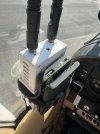Hello fellow Aviators.
I wanted to bring it to your attention that the battery used might swell and expand unknowingly.
I am just blessed this didn’t rupture while airborne with my spouse or other occupants in the plane. Lithium fires scare me, especially at altitude.
I sent a picture to CrewDog Stratux and they seemed to brush it off and simply sent me a link to their replacement parts website. Not sure how I feel about that.
Nothing changed about how I operate to make this battery swell. I flew two days, it was fine.. during preflight yesterday and noticed it was so swollen that the case was cracked open. Outside air temps were not hot or as extreme as anything experienced in July/August. Airplane lives in a hangar, so it’s not an external issue.
This situation somewhat changed my approach to having batteries in the cockpit without a lithium fire bag. It’s seemingly cheap insurance to becoming a fireball at 10,000 feet.
Be safe out there
I wanted to bring it to your attention that the battery used might swell and expand unknowingly.
I am just blessed this didn’t rupture while airborne with my spouse or other occupants in the plane. Lithium fires scare me, especially at altitude.
I sent a picture to CrewDog Stratux and they seemed to brush it off and simply sent me a link to their replacement parts website. Not sure how I feel about that.
Nothing changed about how I operate to make this battery swell. I flew two days, it was fine.. during preflight yesterday and noticed it was so swollen that the case was cracked open. Outside air temps were not hot or as extreme as anything experienced in July/August. Airplane lives in a hangar, so it’s not an external issue.
This situation somewhat changed my approach to having batteries in the cockpit without a lithium fire bag. It’s seemingly cheap insurance to becoming a fireball at 10,000 feet.
Be safe out there



